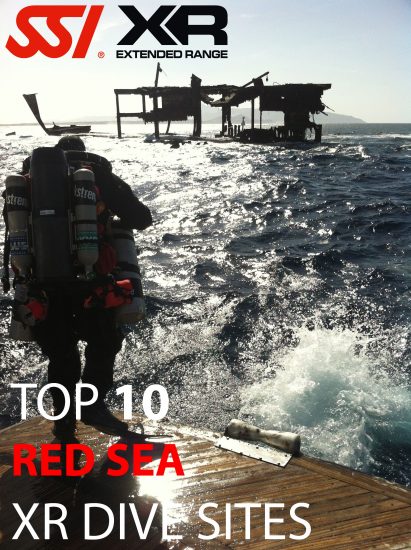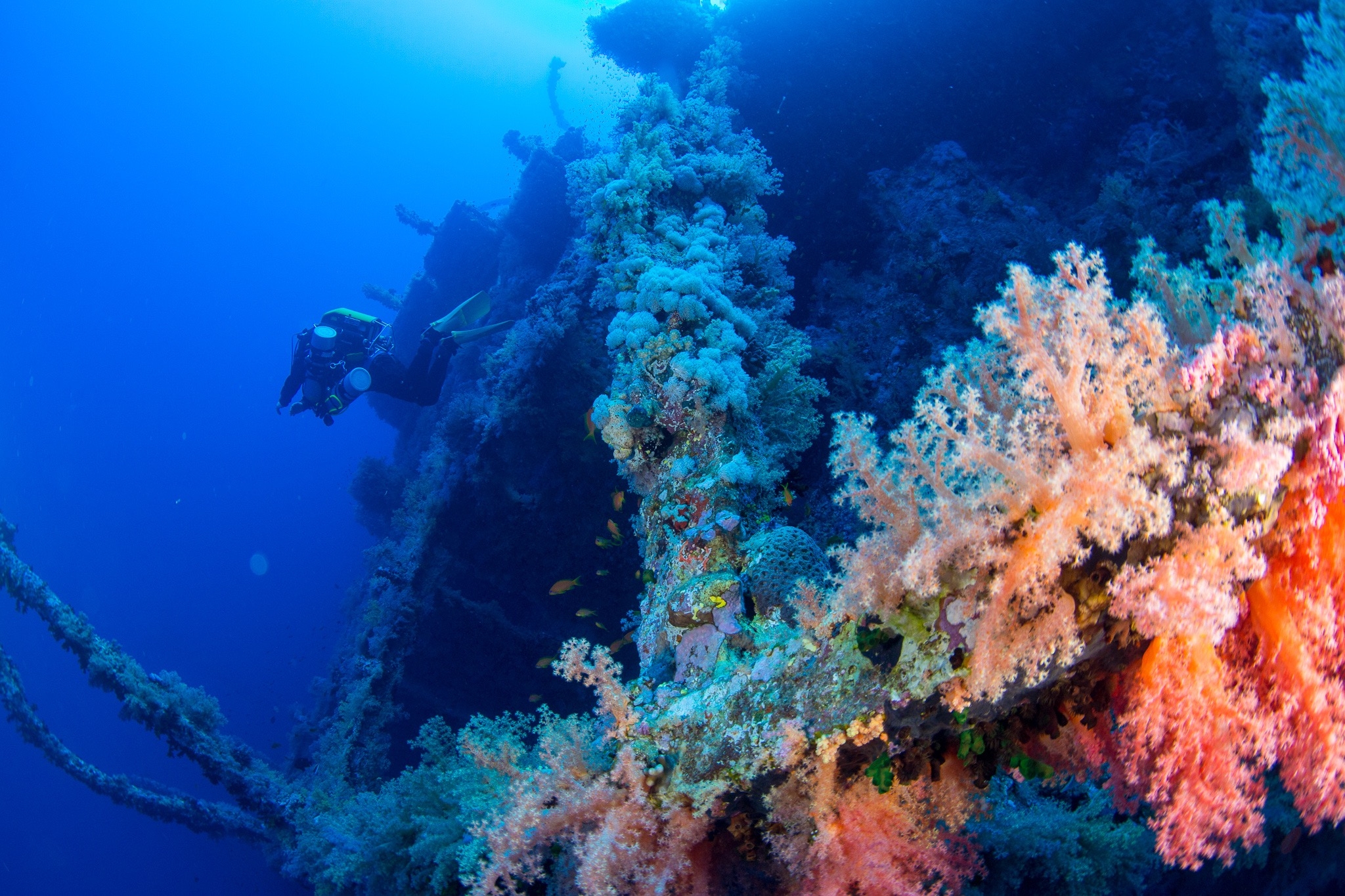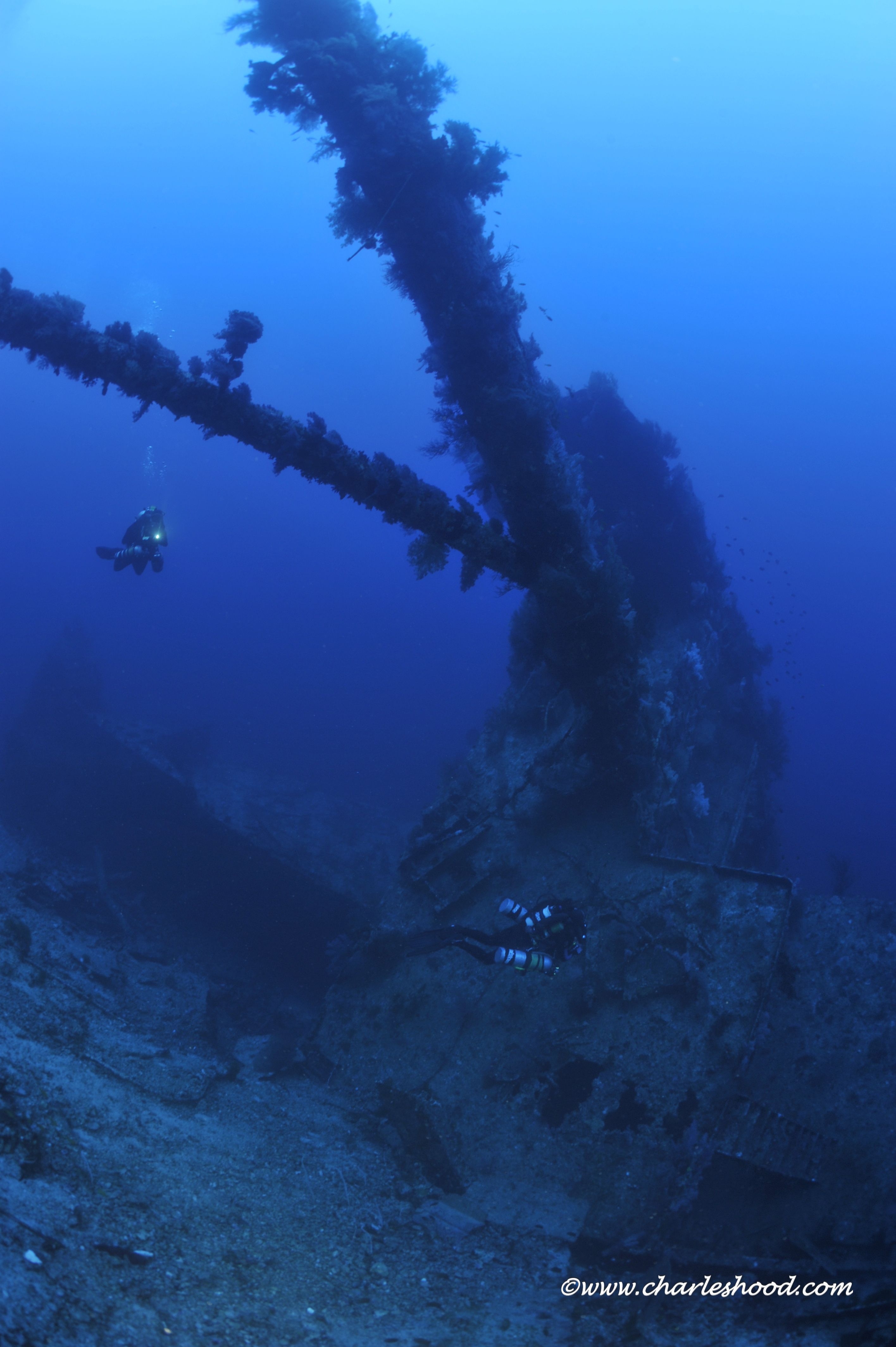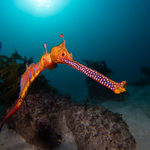
There are many dive sites within the Red Sea that are suitable for XR diving. Each of the sites has their own very unique and distinctive features and highlights. Each diver has his or her own preference and opinion which combines to make them decide which sites would be their favorite site for decompression diving and we here at Tekstreme Diving are no different. As a team we have put together 10 of our favorite XR diving sites from Egypt in the Red Sea. Please note they are in no particular order.
-
Elphinestone Archway @ Marsa Alam by Cat Braun
Situated off the coast of Marsa Alam lies the reef of Elphinestone. This finger long reef stretches from slightly off north to south with a plateau at both ends. Lying underneath the southern plateau is a wide passageway known as the “Arch” which you can swim through between the depths of 45 – 60 meters. Surrounding the entrance and exit is a mass of various soft corals, large gorgonian fan corals and whip corals. This dive site is well known for its currents hence the abundance of coral and marine life that brings the reef to life. As a result of the currents it is also the home to various pelagics. It is a well-known site for seeing Oceanic White Tip Reef Sharks, especially around the southern plateau. Hammerhead sharks are more frequently spotted on the northern tip but definitely not unheard of to also frequent the southern edges of the plateau at depth.
-
Red Sea Wreck Lara @ Sharm El Sheikh by Steve Parry
The Lara is a 137meter-long former cargo ship that ran aground on Jackson Reef in 1982. Originally intact and sitting atop the reef, she was salvaged in the mid-90s resulting in sections of the ship being allowed to be submerged. Today her remains lie against the reef immediately to the west of the surface-based remains. Descending next to the surfaced-based wreckage and swimming ‘reef left’, descend to 45 meters. There you will start to see her ghostly remains appear from the gloom. The remains start at 48 meters with her mast and sections that probably included workshops. Her bulkheads were removed during salvage allowing you to swim in and around this section. Laying on its starboard side you will then see her stern section with an impressively large propeller still attached at a depth of around 55m. Her superstructure and other sections lie at deeper depths. This dive is very weather dependent as the wreck lies against the most northerly, and therefore exposed, side of Jackson Reef. For me this is why the dive is one of the best; it is a dive that many divers take years of failed attempts to complete and so as you enjoy the dive you have the privileged feeling of knowing you are seeing a wreck only very few have enjoyed in the Red Sea!
-
The Blue Hole @ Dahab by Steve Parry
One of the most famous XR dive sites in the Red Sea, the Blue Hole is a giant sinkhole in the reef-plate that drops directly down to 110 meters. Starting the dive from the small wooden jetty, make your descent and turn ‘half-left’. As you descend to 50 meters there you will see the reason everyone want to dive this impressive site. A huge archway in the wall of the hole appears in front of you. Beautifully lit up by the sunshine on the outside of the hole, the archway seems like a massive cathedral window. Beware of dropping to deep though as you gaze into the light; this dive is best done as a trimix dive for this reason! Swim through the arch, enjoying some healthy black gorgonians attached to the roof of the arch and come out onto the outside. From there turn ‘reef right’ and start your decompression. From approximately 20 meters you will find a very colorful coral garden, culminating in a lip at 6 meters serving as the entrance back into the hole. From the lip, swim back into the hole whilst completing your decompression and finish the dive back where you started.
-
The Canyon @ Dahab by Duncan Spenceley
Situated a short drive to the north of Dahab town, “The Canyon” is a popular dive site with both recreational and XR divers alike. Once your equipment is prepared the first step is to walk your stage cylinders out into the shallow, shore entry point. Open heeled fins and boots are highly recommended. You enter the site into a long narrow lagoon in the reef that is clearly visible from the surface and about 4 – 5 meters deep. Swim slowly to the end of this lagoon and you will see a dip in the perimeter that is about 2.5 meters deep. Exit the lagoon here. You will see directly in front of you a prominent pinnacle that starts at around 10 meters and tops out at around 6 meters. Remember this pinnacle as it marks the location of the lagoon for your exit! The seabed gently slopes and is a mixture of sand and coral out crops. Facing out from the pinnacle turn to face approx. 10 o’clock and swim out in this direction sticking to about 10 -12 meters. The bottom will gently fall away from you. The entrance to the canyon is at around 22 meters. When the bottom gets this deep, hang a left until a black opening appears in the seabed. It can take 5 – 10 minutes to reach depending on the current. On reaching the entrance (you will usually see thin bubble trails coming out of the sand unless you are the 1st group in) scan the entrance for other divers. If the canyon is blocked just hang out at 10 meters until they are clear. You descend into a large bowl that bottoms out at around 26 meters. Swim in the direction of the shore and the bowl narrows and looks like it ends. At this point look up and see the light filtering down through the ‘Fishbowl’ and hatchet fish and cave sweepers dancing in the shadows. You used to be able to exit through this passage via the fishbowl which took you up to 12 meters but the structure is now unstable and as a result this exit is closed to diver. Having had a little look there turn 180 degrees and descend the slope further into the canyon. The passage narrows and deepens and wiggles down toward the deeper water. Be careful of your depth as it does slope fairly quickly and as the passage lies on a slope it can be quite disorientating. Towards the base of this passage at around 44 meters there is a small opening that can be used to exit to the open water, or you can carry on through a small narrowing and enter a smaller chamber at around 50 meters. At the end of this chamber is another opening to the open water. Pop out here and you will be on the reef wall / drop off. From here you can either enter the canyon and exit the way you came in swim back over the top of the canyon following the ribbon like crack back towards the reef wall or for the deeper qualified continue down into a depression and visit Neptune’s Chair at 65 meters or even Neptune’s caves at 75 meters. When entering the ascent phase of the dive, follow the canyon up to the fringing reef wall; keep the reef on the right and deco out according to schedule. Keep an eye out for the pinnacle! If you continue slightly past the pinnacle you will see a pristine sandy slope that shallows to 3 meters, ideal if you are into lazy decompression! Exit back out through the lagoon keeping an eye out for sea moths.
-
Yolanda Plateau @ Sharm El Sheikh by Duncan Spenceley
Shark and Yolanda Reef is one of the most popular dive site for all divers in Sharm El Sheikh and as a result can be quite busy. If you want to guarantee some alone time on this popular site then what better way than to visit the Yolanda Plateau which is out of reach to most divers visiting the area. The dive site requires a blue water 70-meter descent so make sure you are comfortable with that!!! Once fully equipped, the boat is positioned between Yolanda Reef and Satellite reef and then moved approx. 100 – 150 meters out into the sea. And away you go. Descend fairly quickly as there can be strong currents to blow you off course. On reaching 70 meters, if you still just see blue, swim north until the plateau looms in front / below you. The tip of the plateau is around 98 meters and the plateau is marked with a large gouge marking the path the Yolanda took to its final resting place past sub 160 meters. Gaze down into the blackness and convince yourself you can make out some portion of the wreck below! Then, follow the plateau up. As is shallows keeping an eye out for cameras, dive computers etc. dropped by other clumsy divers! There are 4 containers on the plateau for you to explore and a section of mast. As you reach the reef wall and start the ascent you will see more debris including toilets complete with lids! At around 45 meters is an anchor with a net around it; often you will find a big moray eel here. Continue up following the scar and it will lead you up to what the recreational divers see. At 26 meters view the stacks of bathtubs and on your journey up to 9 meters take in more toilets, rolls of linoleum, a BMW, and hand-sinks. All are encrusted with coral and full of marine life. Continue round the back of Yolanda reef and visit the beautiful shallow coral garden as you complete your decompression. At the end of your dive move to the front of Yolanda reef and exit back to the boat.
-
Red Sea Wreck of the Gulf Fleet @ Hurghada by Cat Braun
Towards the north end of the Hurghada dive sites you will find the reef of Shaabrugh Umm Gammar. Located on the north east side of the reef you will find the wreck of a cable layer that was part of the Gulf Fleet. The ship hit the reef and then slid down the eastern reef wall to its current position where it got wedged on a hard-coral mound. The wreck is lying pointing downwards with the stern section being the shallowest point at 85 meters, then angled down towards the bow section at around 100 meters. The wreck is completely intact will minimal structural damage. Due to the topography of the reef side it is possible to swim under the keel towards the box at around 105 meters. The visibility in the area is normally very good with natural light still penetrating down to this depth and so you can clearly see wreck without the essential need for torches. The wreck also does not receive large currents and so exploration is a relatively simple process. As the wreck is lying on the reef once you have finished exploring you then get a nice swim during your decompression of the reef side until eventually arriving at the southern end where your boat is normally moored.
-
Red Sea Wreck of Numidia @ Big Brother Island by Cat Braun
Situated towards the middle of the Red Sea you will find two islands that make up what we call the Brother Islands; Big Brother and Little Brother. Little Brother is completely uninhabited but Big Brother provides accommodation for a small team of Egyptian workers who man the lighthouse, act as an outpost and sell Brother Island T Shirts! It is on Big Brother Island where you will find the wreck of the Numidia. The British cargo ship was a relatively large vessel at 137.4 meters long, 16.7 meters wide and had a draught of 9.2 meters. The Numidia struck the northern most tip of the reef due to a navigational error. The strong currents in this area combined with the winds that can be experienced in the Red Sea makes this dive suitable for a more experienced diver. You can only dive the wreck by a zodiac drop with your main boat being moored up on the more sheltered southern end to the reef. Once you roll into the water from the zodiac you will see the wreck directly beneath you starting at its shallowest point of around 10 meters, however, it is critical to make a swift decent to get shelter from the currents that can blow you off the wreck and potentially on top of the reef. Once you are down and have protection from the current you can follow the structure of the wreck to your planned maximum depth. The wreck is sat up right alongside the reef with the bow section, all be it slightly broken up at the shallowest point at around 10 meters, and the stern section coming to rest at around 80 meters which is the deepest point. The first thing that most people will comment on is the absolute color that now adorns this vessel. Hard corals and soft corals have colonized this ship in a manner making it amongst one of the most beautiful shipwrecks in the world. The railings, masts, lifeboat davits, windlasses and deck winches are all still in place – having become part of a living Reef of such vibrancy that it is easy to lose sight of the fact that this is a “wreck dive!” The wooden decking has gone and the cargo was salvaged. This, however, provides a great opportunity to investigate a large ship at whatever depth suits the personal requirement. Forward of the central bridge are two cavernous cargo holds with ventilation hatches along the starboard side. The decks are now a square pattern of steel in between which is the lower half of the forward mast. As you make your way up the wreck you will ultimately end up back at the eastern reef wall of the island ready to begin your deco. Head with the reef more commonly on the left-hand side and do not forget to keep an eye out in the blue. Multiple varieties of pelagics can be found on this Island.
-
Small Giftun @ Hurghada by Cat Braun
The marine park of Hurghada is made up of the two Giftun Islands; Big Giftun and Small Giftun. It is on Small Giftun Island that you will find one of the most popular drift dives in the area so titled “Small Giftun Drift”. You may come across this dive site by a few other names which could include; “The Police Station”, aptly named as there is a patrol outpost in the area, or “Gorgonia Gardens” due to the amount of Gorgonian fan corals that can be found on the site. The eastern wall of the island is where you begin you dive and it is a wall dropping to depths below 150 meters, however, the best depth for the dive is between 60 – 70 meters. You will find yourself drifting along through a beautiful green soft coral forest with long whip corals and Gorgonian fan corals along the way. With a bit of local knowledge, you will also be able to time your ascent to swim through a narrow crack in the reef, commonly referred to as “The Giftun Archway”. You would make your entrance at around 47 meters and exit at 43 meters. The current in the area can be strong hence so much soft coral growth even at depth. Hurghada diving is not renowned for Pelagics but it is not unheard of to see a Thresher Shark who has made his home within this area cruising by.
-
Thomas Canyon @ Sharm El Sheikh by Chris Armstrong
Situated in the straits of Tiran are four reefs stretching from north to south. The second reef from the south is Thomas Reef. Halfway along this reef on the eastern side is a deep underwater fissure, what we commonly refer to as “Thomas Canyon”. The canyon is approximately 80 meters in length. It begins at a depth of 35 meters and gradually gets deeper. At the shallowest point it is quite narrow and drops to a sand base at approximately 42 meters. As we proceed down through the canyon you will see there are three arches above you created by falling boulders. The first arch is at 42 meters; the second is at 50 meters and the third and final arch at 52 meters. To the right-hand side and deeper at 62 meters is a short tunnel swim-through which exits between 66 – 69 meters. After passing the arches the canyon widens and can easily accommodate two divers’ side by side. Towards the northern end, the shallowest part of the canyon is 50 meters with the deepest at 90 meters under a rocky overhang. This is an ideal site for all levels of XR diver and as there is no current in the canyon which makes for a relaxing dive although usually there will be current upon exit to ascend the wall for decompression obligations. There is an abundance of marine life on the main reef wall and its common to see tuna, fusiliers and blue fin trevally patrolling by.
-
Red Sea Wreck of Rosalie Muller @ Gobal by Cat Braun
The ship of the Rosalie Moller was 108.2 meters long. She was ideal for collier duties and was making a significant contribution by transporting anything up to 4,500 tons of best Welsh coal to whichever port the Royal Navy demanded. In July 1941, The Rosalie Moller entered the Red Sea and, on reaching the Gulf of Suez, was assigned “Safe Anchorage H”. Late at night on the 5th October 1941, two twin-engine Heinkels crossed the north Egyptian coast heading southeast in search of a prize. They attacked and sank the Thistlegorm during the early hours of the 6th October, detonating much of her ammunition. In so doing, the night sky was briefly illuminated revealing more vessels at anchor. 48 hours later, on the night of 7th October, the Rosalie was hit and went down.
The Rosalie Moller now stands upright on the seabed. As you make you way down the shot line to the wreck you will notice that the visibility within this area is not as clear as most outside reefs. Instead of this being a negative comment it is actually meant as a positive as it gives the wreck a nice almost eerie atmosphere to it. There are normally two permanent mooring lines on this wreck but they do have a tendency to move around the wreck, so do not always expect to find them where they were on your last diving trip! The first thing you may see as you approach the wreck is the forward mast which is now angled to one side due to collapse, with the masthead lamp in place at 17 meters. Below this, the bows is at 39 meters and the starboard anchor is deployed with the chain running down to the seabed at 47 meters and then out of sight. The cargo hatches are gone, revealing the full cargo of best Welsh coal still in place. Pots and pans still hang in the galley where they are now concreted to the walls above a large stove. Although the wooden decks have rotted away, all the portholes are still in place. Aft of the bridge, the funnel is still standing – with only the slightest list to port. You will clearly see the major damage to made to the ship by the bomb, it is like it has torn a hole out of the side of the ship and upper decking. The thing that I like the most about this wreck is the fact that it is has not been dived as much as its sister ship the Thistlegorm, and because of the fact that is it is slightly deeper it means that it is not suitable for the novice diver, again keeping numbers of divers down. As a direct result of these factors the marine life is superb. You must descend through an upper deck area walled with glass fish and cave sweepers, big Tunas are patrolling the masts above your head, multiple peppered moray eels have made their homes along the path ways along with the thousands of tube works, nudi-branches and flat worms. For me this is a wreck that combines history and marine life, and as it lies only at maximum 47meters you can have a super long dive on the wreck without too much deco.
Many thanks to Charles Hood and Duncan Spenceley for some excellent photos. If you would like to dive any of the sites mentioned in our Top 10, Tekstreme Diving offer daily trips or liveaboards so that you can get the best experience. Head to https://www.tekstremediving.com/ for further information.


The post Top 10 XR Dive Sites of the Red Sea appeared first on Dive SSI.
Read MoreExtended Range, Blue Hole, Elphinestone, red sea, Rosalie Muller, Thomas Canyon, Top 10 Dive Sites, wrecks, Yolanda PlateauDive SSI

